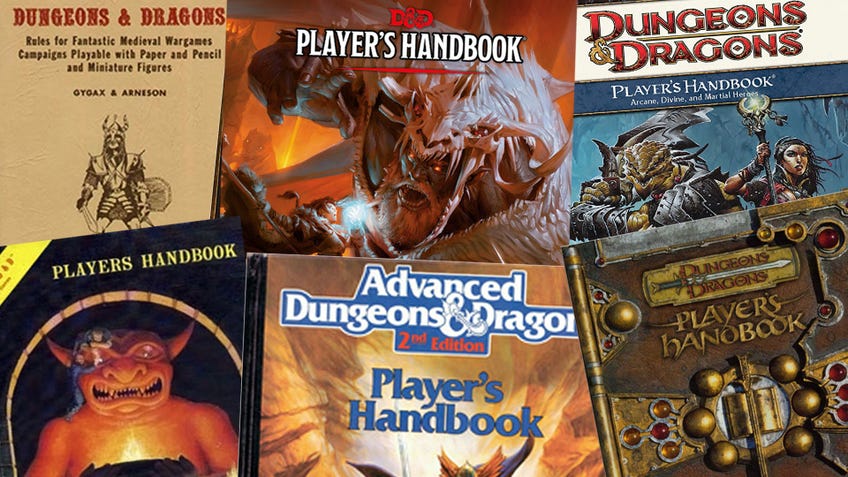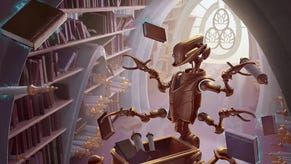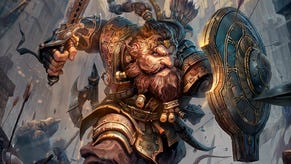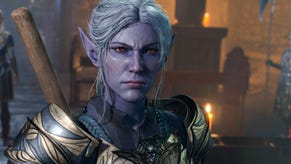Which edition of Dungeons & Dragons is best? D&D edition differences from OG to 5E
From the 1974 original to the RPG's latest Fifth Edition, we run through what makes each D&D edition worth playing (or not).
From OG to 5E, each one of Dungeons & Dragons’ editions brings something unique to the tabletop. But what are the differences between each D&D edition? And which D&D edition is best?
In this guide we’re going to take you through each edition of Dungeons & Dragons, from publisher TSR’s original creation in 1974 (which actually required the use of a separate gaming system to play it) to Wizards of the Coast’s acquisition of the fantasy RPG and its latest evolution in D&D 5E.
D&D edition differences
- Original Dungeons & Dragons (1974)
- Advanced Dungeons & Dragons (1977)
- Advanced Dungeons & Dragons 2E (1989)
- Dungeons & Dragons 3E (2000)
- Dungeons & Dragons 3.5 (2003)
- Dungeons & Dragons 4E (2008)
- Dungeons & Dragons 5E (2014)
- What is the best D&D edition?
As we go through the different D&D editions, we’ll look into the story behind each edition, explaining how the roleplaying game has changed over the years - from its basic gameplay to the races and classes players use to create their characters - and why each edition has its own fans. Of course, we’ll also give our own thoughts on which edition of Dungeons & Dragons is best for most players.
Original Dungeons & Dragons
The D&D edition that started it all
Year released: 1974

This initial iteration of D&D was simply that: Dungeons & Dragons. It has since been renamed Original Dungeons & Dragons in order to set it apart from other editions of the roleplaying game. This ‘0th Edition’ of D&D, as it’s sometimes called, was created with a budget of just $2,000, published as a box set in 1974 and is barely recognisable in comparison to the RPG we know today.
There were only three character classes available: Fighting-Man, Magic-User and Cleric. Along with that, there were only four races playable, including Human, Dwarf, Elf and Hobbit. The guide to playing the game consisted of three rulebooks: Men & Magic, Monsters & Treasure and The Underworld & Wilderness Adventures.
Men & Magic was created as a 34-page booklet which laid out the rules for playing your character, taking part in combat and casting spells. This book originally suggested that the game could be played with between four and 50 players, with the dungeon master (then named Referee) creating their own dungeon (or underworld).
It was detailed in this set of rules that Dwarves and Hobbits could only play Fighting-Men, Elves could switch between Fighting-Men and Magic Users, and Humans - as the default character option - could pretty much do whatever they wanted.
To set your ability scores, 3d6 were rolled by the Referee. This resulted in an ability score range between 3 and 18. The maximum spell level was sixth and the maximum character level was 16th.
The first edition of D&D was basically a wargame with a Lord of the Rings/medieval twist. It followed the rules of popular wargames at the time - which included Chainmail, the medieval miniature wargame which was also made by TSR.
Dungeons & Dragons’ release in 1974 provided a stepping stone for competing RPG publishers who wanted to break into the market with something similar. These included Tunnels & Trolls, which was released the following year and aimed to be an even more accessible roleplaying game than D&D.
Despite the number of Dungeons & Dragons editions that have followed, and old-school RPGs inspired by the 1970s rules, a number of fans continue to play Original D&D to this day.
Advanced Dungeons & Dragons
A step up for veteran players
Year released: 1977-1979

As you might have guessed from the ‘Advanced’ moniker, this edition of Dungeons & Dragons wasn’t for the faint of heart or complete newcomers to roleplaying. The rules for playing in Advanced D&D were incredibly hard to follow unless you had been playing the original for a long while.
In fact, it was difficult to even gain access to each rulebook (the Player’s Handbook, Dungeon Master’s Guide and Monster Manual), due to the fact that publisher TSR didn’t have the money to release them all at the same time. Each of the three books was released over the course of three years, from 1977 to 1979, resulting in widespread confusion about how exactly the game should be played.
However, there were some major additions in this advanced version of the RPG which were important for any player to take advantage of. These included new D&D classes seen in supplements, such as assassin, druid, monk, paladin and thief, and the official introduction of bard, illusionist and ranger. Alignments were also changed; instead of the previous three-alignment system, a new nine-alignment system was introduced.
From 1977 until 2000, Dungeons & Dragons would be divided into two categories, Basic D&D and Advanced D&D, hoping to inspire new players to give the basic version a chance.
Advanced Dungeons & Dragons 2E
A beginner-friendly version of the hardcore ruleset
Year released: 1989
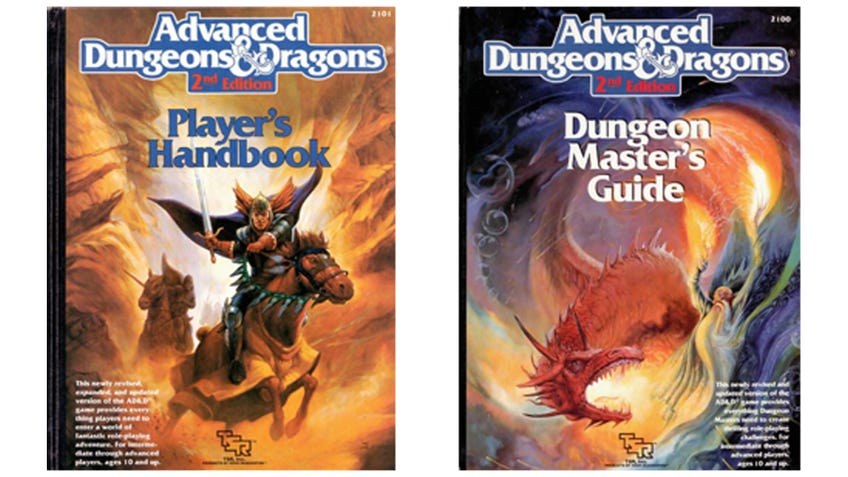
Naturally, with a new edition of Dungeons & Dragons, you expect to see improvements to what was released previously. One of the major benefits of using the second-edition Advanced Dungeons & Dragons ruleset was it was simplified, making it far easier to understand the rules. The first AD&D offering was very much designed to be for hardcore players of the RPG, making it overly complicated and difficult to take in. The second edition of AD&D solved this problem and effectively presented the AD&D that should have been created in the first place.
This was released a full ten years after the first edition of Advanced D&D, and so any issues with the prior version were going to be very apparent. With those fixed and a nostalgia kick offered to original players, it was always going to be something of a hit.
The second edition of Advanced Dungeons & Dragons eventually led to a re-release of a much cleaner Player’s Handbook and Dungeon Master’s Guide in 1995, filled with a substantial amount of new artwork, alongside a set of variant rules known as the Player's Option series.
Dungeons & Dragons co-creator Gary Gygax claimed that this whole rework was to deny him royalties on sales for the previous edition. (It was actually because the previous edition of AD&D needed perfecting - Gygax not getting royalties was just an added bonus.)
It was also, in part, due to the fact that Dungeons & Dragons was getting some negative publicity by the God-fearing public who had gotten wind of the roleplaying game and believed it was devil worship as part of a growing Satanic panic. In order to quell these worries, all mention of ‘devils’ and ‘demons’ were removed and replaced with fiendish equivalents known as tanar'ri and baatezu. To complete the attempt at marketing Advanced Dungeons & Dragons 2E as a wholesome game that was perfectly suitable for teens and up, the focus was shifted towards heroics and teamwork as opposed to battling monsters and straight-up murder.
A few additions to this edition that you may recognise include armour class, movement being measured in feet and optional critical hit rules. Proficiencies were also no longer an optional add-on but became fully supported in the core rules.
Dungeons & Dragons 3E
The birth of the d20 system
Year released: 2000
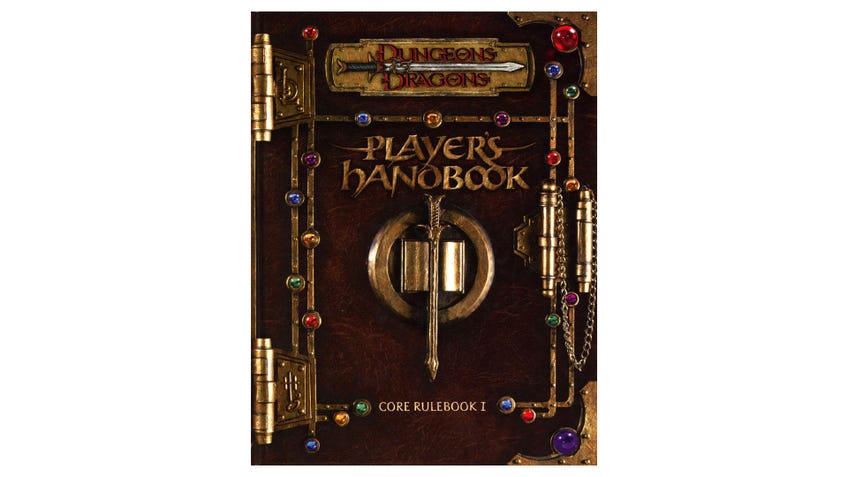
Here we are at third-edition D&D, the first D&D edition published by Magic: The Gathering maker Wizards of the Coast after its acquisition of TSR in 1997. At this point, Wizards decided to drop the ‘Advanced’ element of the RPG, joining the Basic version which had been discontinued some years ago, simplifying the game to just Dungeons & Dragons.
The release of Dungeons & Dragons 3E also brought about a brand new system: the d20 system. This new mechanic brought about a much more unified system of gameplay, with the majority of actions requiring a d20 roll to resolve them. Along with this, gameplay was simplified across the board, with ability score modifiers following a set formula and saving throws reduced from five categories to three, based on defence rather than attacks. Combat in D&D 3E was also put in the spotlight, encouraging tactical gameplay with miniatures to be played on a grid system.
Big character changes came in the form of a new class, sorcerer, while the thief became the rogue - with rogue having previously been used to represent both the thief and bard classes.
Players were given the chance to ‘prestige’ their characters when they reached higher levels, allowing them to advance their characters beyond level 20.
Dungeons & Dragons’ third edition also gave players the freedom to make any race and any class work together, rather than the set restrictions of the past - which continues to be a little ridiculous in retrospect. Skills and feats were also introduced, allowing players to customise their characters to their hearts’ content.
Dungeons & Dragons 3.5
An improved version of Third Edition that would become one of D&D's most popular releases ever
Year released: 2003
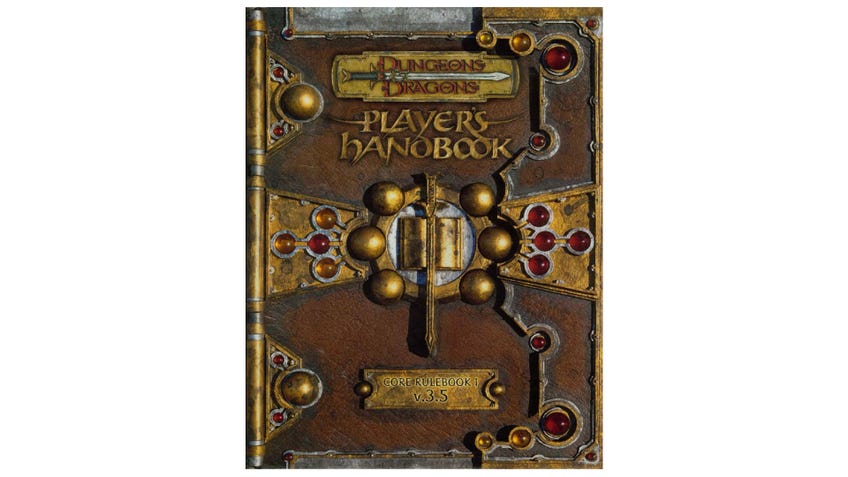
A mere three years after D&D 3E, it was overshadowed by another shiny new edition: 3.5. With Wizards having completed its initial overhaul of the ruleset and officially put its mark on the RPG, it was only natural that it would want to make a few edits based on player feedback and common complaints. In essence, it took the third edition and made it the best it could be, which is why it was dubbed edition 3.5.
For a lot of Dungeons & Dragons players, D&D 3.5 is the best of the best. That doesn’t mean it was a completely successful release, however, as many players who had invested in the Player's Handbook and Dungeon Master’s Guide for 3E only a few years before resented having to go out and buy brand new books in order to play 3.5.
According to Roll20’s data for the first quarter of 2021, D&D 3.5 is still among the most played RPGs on the virtual tabletop platform today - the only other edition of Dungeons & Dragons listed in the top ten is D&D 5E. We’ll get to that in a moment though - first, there’s another D&D edition for us to take a look at.
Dungeons & Dragons 4E
D&D's most controversial edition to date
Year released: 2008
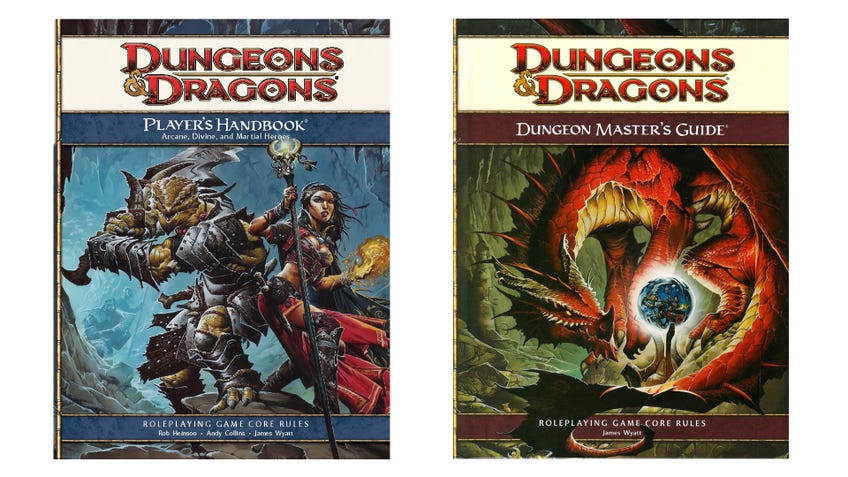
You may have heard that there is a lot of hate out there for fourth-edition D&D - and there is certainly a reason for the criticism lodged against it.
Once again, with the previous edition of D&D only having been released a handful of years prior, some players refused to move on to 4E and instead continued to rely on D&D 3.5 or even the RPGs that had spawned from it, such as Pathfinder.
Despite this, the initial run of Dungeons & Dragons’ fourth edition sold out ahead of the game’s full release in the summer of 2008 and a second print run had to be announced soon after.
D&D 4E is incredibly combat-focused, with the use of miniatures becoming mandatory and classes taking up roles you might be more familiar with in an MMO video game, such as tank or DPS. Accordingly, many fans accused Wizards of the Coast of trying to make D&D more like hit PC game World of Warcraft, losing the heart of Dungeons & Dragons in the process. This extended to the introduction of loot box-like blind packs of miniatures that made the game exceptionally expensive to play.
Characters were now able to go up to level 30, as opposed to the traditional cap of level 20. Despite this upside, players found that this edition was less about building an interesting character and roleplaying them throughout your journey, and more about tactical gameplay, making the experience feel very unbalanced.
Based on the fourth-edition ruleset, Dungeons & Dragons Essentials was brought out three years after this in 2010, trying to attract new players rather than established ones. It wasn’t until the development of the next edition that many new players felt truly welcome, though.
Dungeons & Dragons 5E
The latest - and greatest? - D&D edition
Year released: 2012-2014
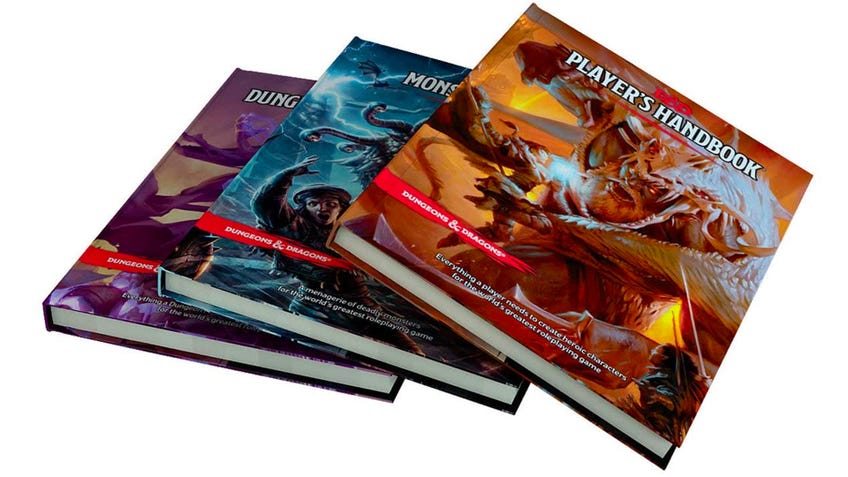
The latest version of D&D to date, Dungeons & Dragons 5E was first made available in January 2012 and completely revolutionised the RPG by developing it through a public open playtest for the first time. As well as this player-friendly development style, a Basic Rules PDF was released for free in 2014, allowing new potential players to see what they were in for.
5E’s full Starter Set released in July 2014 and contained pre-generated characters, instructions for basic play and an adventure module entitled Lost Mine of Phandelver. Since 2014, over 40 fifth-edition books, supplements and sourcebooks have been published, including adventure modules, rulebooks and various gameplay guides.
According to Wizards of the Coast, Dungeons & Dragons 5E is the most successful edition of D&D to date, thanks in part to the emergence of actual play streams such as Critical Role, Dimension 20 and Dicebreaker’s own Dungeonbreaker. This has allowed for the introduction of countless new players to the roleplaying game.
Of course, it makes sense that this edition has been hailed as one of the best D&D editions, as it represents decades of additions and improvements, building on D&D’s most popular aspects as well as correcting its mistakes over the years. Gameplay is streamlined, allowing for a focus on roleplay, combat and character creation in equal measure.
Notable changes include a single proficiency bonus that increases alongside your character’s level, a single value for armour class and saving throws that fall in line with your character’s six core abilities (strength, dexterity, intelligence, constitution, wisdom and charisma). Feats are optional, and can be taken instead of an ability score increase. Dungeons & Dragons 5E also introduced advantage and disadvantage, with players rolling 2d20 and using either the higher or lower result depending on the situation.
D&D 4E's power system became class features, with the list expanding as the character levels up. Clerics, druids, paladins and wizards prepare their spells using a slightly improved preparation system, which takes a lot of influence from previous editions, and healing surges are replaced by hit dice.
What is the best D&D edition?
5E may be most popular, but is it really the best D&D?
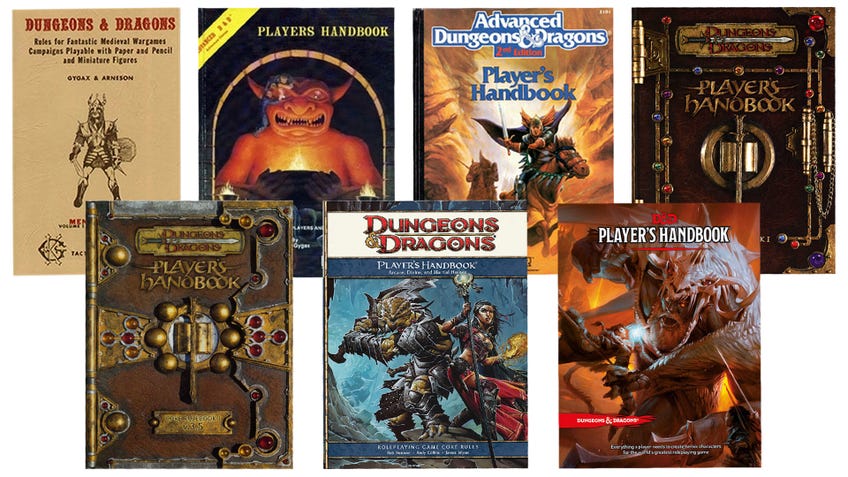
In our opinion, the best edition of Dungeons & Dragons is D&D 5E, with D&D 3.5 being a close second.
Of course, there’s room to mess up a later edition of a game - D&D 4E is proof of that - but 5E not only fixed what was broken and improved upon what worked in previous D&D editions, it also saw Wizards of the Coast reach out to fans themselves to hear what they wanted in a new edition of Dungeons & Dragons.
Wizards of the Coast continues to experiment with ideas for Dungeons & Dragons, with D&D 5E’s Unearthed Arcana content allowing players to try out new things. Who knows - maybe we’ll see some of those same ideas surface in an eventual Dungeons & Dragons 6E.
Until then, Dungeons & Dragons 5E is still the best choice for beginners looking to play D&D today. It's the easiest D&D edition to learn, the most generous when it comes to the amount of extra adventures, sourcebooks and supplements available, and also happens to be easy to find in your local hobby store. You can even pick up the basic rules for free and start playing.
Do you agree with our pick? What's your favourite edition of D&D? Let us know in the comments!
